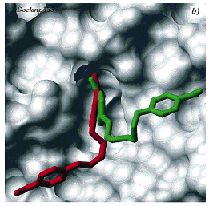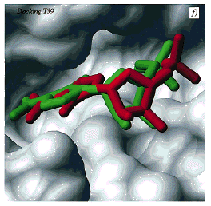2.3 Drug Design & Docking
2.3.1 Flexible protein-ligand docking
  > |
|
| Predicted docking conformations are shown in red and
conformations determined by x-ray crystallography are shown in
green. Analytical molecular surface of protein receptors was
generated with the contour-buildup method as implemented in
the ICM program. |
Eight protein-ligand complexes were simulated by using global optimization of a complex energy
function, including solvation, surface tension, and side-chain entropy in the internal coordinate space of
the flexible ligand and the receptor side chains [Abs].
The procedure uses two types of efficient random moves, a pseudo-brownian positional move
[Abs] and a Biased-Probability
multitorsion move [Abs], each accompanied by
full local energy minimization. The best docking solutions were further ranked according to the
interaction energy, which included intramolecular deformation energies of both receptor and ligand,
the interaction energy, surface tension, side-chain entropic contribution, and an electrostatic term
evaluated as a boundary element solution of the Poisson equation with the molecular surface as a
dielectric boundary. The geometrical accuracy of the docking solutions ranged from 30% to 70%
according to the relative displacement error measure at a 1.5 A scale. Similar results were obtained
when the explicit receptor atoms were replaced with a grid potential.
[Proteins - 1997] [PDF]

